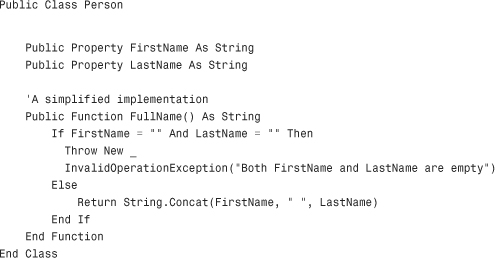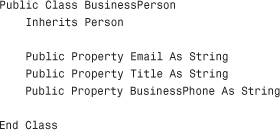- Title Page
- Copyright Page
- Dedication
- Contents at a Glance
- Table of Contents
- Foreword
- About the Author
- Acknowledgments
- We Want to Hear from You!
- Reader Services
- Part I. Learning the Basics of VB
- Chapter 1. Introducing the .NET Framework 4.0
- Chapter 2. Getting Started with the Visual Studio 2010 IDE
- Chapter 3. The Anatomy of a Visual Basic Project
- Chapter 4. Data Types and Expressions
- Chapter 4. Data Types and Expressions
- Common Type System
- Understanding Value Types
- Understanding Reference Types
- Differences Between Value Types and Reference Types
- Converting Between Value Types and Reference Types
- Conversion Operators
- Working with .NET Fundamental Types
- Common Operators
- Iterations, Loops, and Conditional Code Blocks
- Chapter 5. Debugging Visual Basic 2010 Applications
- Chapter 6. Handling Errors and Exceptions
- Part II. Object-Oriented Programming with Visual Basic 2010
- Chapter 7. Class Fundamentals
- Chapter 8. Managing an Object’s Lifetime
- Chapter 9. Organizing Types Within Namespaces
- Chapter 10. Modules
- Chapter 11. Structures and Enumerations
- Chapter 12. Inheritance
- Chapter 13. Interfaces
- Chapter 14. Generics and Nullable Types
- Chapter 15. Delegates and Events
- Chapter 16. Working with Collections
- Chapter 16. Working with Collections
- Understanding Collections Architecture
- Working with Nongeneric Collections
- The ArrayList Collection
- The Queue Collection
- The Stack Collection
- The HashTable Collection
- The ListDictionary Collection
- The OrderedDictionary Collection
- The SortedList Collection
- The HybridDictionary Collection
- The StringCollection Collection
- The StringDictionary Collection
- The NameValueCollection Collection
- The BitArray Collection
- The Bitvector32 Collection
- Working with Generic Collections
- The List(Of T) Collection
- Working with Collection Initializers
- The ReadOnlyCollection(Of T) Collection
- The Dictionary(Of TKey, TValue) Collection
- The SortedDictionary(Of TKey, TValue) Collection
- The ObservableCollection(Of T) Collection
- The ReadonlyObservableCollection(Of T) Collection
- The LinkedList(Of T) Collection
- The Queue(Of T) and Stack(Of T) Collections
- Building Custom Collections
- Concurrent Collections
- Chapter 17. Visually Designing Objects
- Chapter 18. “Generate From Usage” Coding Techniques
- Part III. Advanced VB Language features
- Chapter 19. Manipulating Files and Streams
- Chapter 20. The My Namespace
- Chapter 21. Advanced Language Features
- Part IV. Data Access with ADO.NET and LINQ
- Chapter 22. Introducing ADO.NET and DataSets
- Chapter 23. Introducing LINQ
- Chapter 24. LINQ to Objects
- Chapter 24. LINQ to Objects
- Introducing LINQ to Objects
- Querying in Memory Objects
- Introducing Standard Query Operators
- Projection Operators
- Restriction Operators
- Aggregation Operators
- Understanding the Let Keyword
- Conversion Operators
- Generation Operators
- Ordering Operators
- Set Operators
- Grouping Operators
- Union Operators
- Equality Operators
- Quantifiers
- Concatenation Operators
- Elements Operators
- Partitioning Operators
- Chapter 25. LINQ to SQL
- Chapter 26. LINQ to DataSets
- Chapter 27. Introducing ADO.NET Entity Framework
- Chapter 28. Manipulating Xml Documents with LINQ and Xml Literals
- Chapter 29. Overview of Parallel LINQ
- Part V. Building Windows Applications
- Chapter 30. Creating Windows Forms 4.0 Applications
- Chapter 31. Creating WPF Applications
- Chapter 31. Creating WPF Applications
- What Is WPF?
- WPF Architecture
- Building WPF Applications with Visual Studio 2010
- Understanding the eXtensible Application Markup Language (XAML)
- Understanding Visual Tree and Logical Tree
- Handling Events in WPF
- Arranging Controls with Panels
- Managing Windows
- Introducing the Application Object
- Brief Overview of WPF Browser Applications
- Chapter 32. WPF Common Controls
- Chapter 32. WPF Common Controls
- Introducing WPF Controls Features
- Understanding the ContentControl
- Understanding Common Controls
- Border
- Button
- Calendar
- CheckBox
- ComboBox
- DataGrid
- DatePicker
- DocumentViewer
- Ellipse
- Expander
- Frame
- GroupBox
- Image
- Label
- ListBox
- ListView
- MediaElement
- Menu
- PasswordBox
- ProgressBar
- RadioButton
- Rectangle
- RichTextBox
- ScrollBar
- ScrollViewer
- Separator
- Slider
- StatusBar
- TabControl
- TextBlock
- TextBox
- ToolBar
- TreeView
- WebBrowser
- WindowsFormsHost
- Using Common Dialogs
- Chapter 33. Brushes, Styles, Templates, and Animations in WPF
- Chapter 34. Manipulating Documents and Media
- Chapter 35. Introducing Data-Binding
- Chapter 36. Localizing Applications
- Part VI. Building Web Applications
- Chapter 37. Building ASP.NET Web Applications
- Chapter 38. Publishing ASP.NET Web Applications
- Chapter 39. Building Rich Internet Applications with Silverlight
- Chapter 39. Building Rich Internet Applications with Silverlight
- Introducing Silverlight
- Creating Silverlight Projects with Visual Basic 2010
- Adding Controls and Handling Events
- Playing Media
- Animating UI Elements
- Introducing Navigation Applications
- Introducing WCF RIA Services
- “Out of Browser” Applications
- Chapter 40. Building and Deploying Applications for Windows Azure
- Part VII. Networking and Exposing Data Through Networks
- Chapter 41. Creating and Consuming WCF Services
- Chapter 42. Implementing and Consuming WCF Data Services
- Part VIII. Advanced .NET Framework with VB 2010
- Chapter 43. Serialization
- Chapter 44. Processes and Multithreading
- Chapter 45. Parallel Programming
- Chapter 46. Working with Assemblies
- Chapter 47. Reflection
- Chapter 48. Coding Attributes
- Chapter 49. Platform Invokes and Interoperability with the COM Architecture
- Chapter 50. Documenting the Source Code
- Chapter 51. Advanced Compilations with MSBuild
- Chapter 52. Building Customizations for Microsoft Office
- Part IX. Applications Deployment
- Chapter 53. Understanding the Global Assembly Cache
- Chapter 54. Setup & Deployment Projects for Windows Installer
- Chapter 55. Deploying Applications with ClickOnce
- Part X. Mastering the Visual Studio 2010 IDE
- Chapter 56. Advanced IDE Features
- Chapter 57. Introducing the Visual Studio Extensibility
- Chapter 58. Advanced Analysis Tools
- Chapter 59. Testing Code with Unit Tests, Test-Driven Development, and Code Contracts
- Appendixes
- Index
Applying Inheritance
Before explaining how inheritance is applied in code, a graphical representation can be useful. Figure 12.1 shows how you can create robust hierarchies of custom objects with inheritance.
Figure 12.1 A graphical representation of a custom framework of objects using inheritance.

You derive a class from a base class using the Inherits keyword. For example, consider the following implementation of the Person class that exposes some basic properties:

Inherits System.Object
In the .NET Framework development, every class inherits from System.Object. Because of this, there is no need to add an inherits directive each time you implement a custom type, because the Visual Basic compiler will do this for you behind the scenes.
The class also offers a FullName method that returns the concatenation of the two FirstName and LastName properties, providing a simplified and basic validation that here is for demonstration purposes. Now we can design a new class that inherits from Person, and in this scenario Person is the base class. The new class is named Contact and represents a personal contact in our everyday life:

Contact is the derived class. It receives all public members from Person (in this example both the FirstName and LastName properties and the FullName method) and provides implementation of custom members. This is a typical application of .NET inheritance, in which one derived class inherits from the base class. The .NET Framework does not enable inheriting from multiple classes. You can create a derived class from only a base class. But there are situations in which multiple levels of inheritance would be required; continuing the example of the Person class, there are several kinds of people that you will meet in your life, such as customers, employees of your company, and personal contacts. All these people will have common properties, such as the first name and the last name; therefore, the Person class can be the base class for each of them, providing a common infrastructure that can then be inherited and customized. But over a person representation, if you consider a customer and an employee, both people will have other common properties, such as a title, a business phone number, and an email address. They will differ in the end because of proper characteristics of their role. For this purpose you can implement intermediate classes that are derived classes from a first base class and base classes for other and more specific ones. For example, you could implement an intermediate infrastructure for both customers and employees. The following code snippet provides a class named BusinessPerson that inherits from Person:

This class inherits the FirstName and LastName properties from Person (other than methods such as ToString and other public methods exposed by System.Object) and exposes other common properties for classes with a different scope. For example, both a customer and an employee would need the preceding properties but each of them needs its own properties. Because of this, the BusinessPerson class is the intermediate derived class in the hierarchic framework of inheritance. Now consider the following classes, Customer and Employee:

Both classes receive the public properties from BusinessPerson and both implement their custom properties according to the particular person they intend to represent. We can summarize the situation as follows:
Customer exposes the following properties:
• FirstName and LastName, provided at a higher level by Person
• Email, Title, and BusinessPhone provided by BusinessPerson
• CustomerID, CompanyName, Address, and ContactPerson provided by its implementation
Employee exposes the following properties:
• FirstName and LastName, provided at a higher level by Person
• Email, Title, and BusinessPhone provided by BusinessPerson
• EmployeeID, HomePhone, MobilePhone, and HireDate provided by its implementation
Because at a higher level we also exposed a method named FullName, which has public visibility, such a method is also visible from derived classes.
Members’ Scope and Inheritance
Remember that only Public, Protected, Friend, and Protected Friend members can be inherited within derived classes.
When available, you can use derived classes the same way as you would do with any other class, even if you do not know at all that a class derives from another one. The following, simple code demonstrates this:

Until now we saw only properties in an inheritance demonstration. Methods are also influenced by inheritance and by interesting features that make them powerful.
Inheritance and Common Language Specification
The Common Language Specification establishes that a CLS-compliant class must inherit only from another CLS-compliant class; otherwise, it will not be CLS-compliant.
-
No Comment
